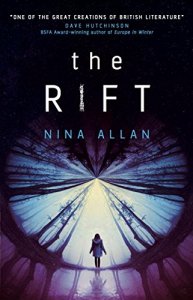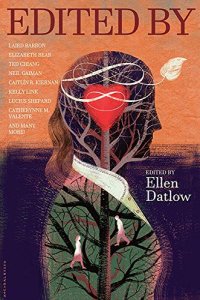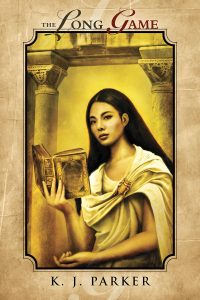Gary K. Wolfe Reviews Nina Allan’s The Rift
The Rift, Nina Allan (Titan 9781785650376, $14.95, 423pp, tp) July 2017.
 Writers get labeled subversive for all sorts of reasons. You can subvert a traditional tale by autopsying its innards, as Angela Carter and others did with fairy tales; you can subvert a traditionally masculinist form by leaving the men out entirely, as Kameron Hurley recently did in The Stars Are Legion with space opera; you can subvert a problematic story by simply twisting the point of view, as several folks are now doing with Lovecraft. Nina Allan has always struck me as a subversive writer in a more purely formal narrative sense: playing with both the familiar protocols of genre and with the nature of the reading experience itself. Stardust is a series of stories which end up weaving in and out of each other like a Celtic cross, while The Race begins with some familiar SF furniture – an environmentally ravaged near-future England, secret government projects, etc. – but shifts points of view so adroitly that we’re not always certain which character is in which other character’s story. Both of those books invited us to repeatedly test our notions of what was real and what was told, and that same testing of reality is at the center of The Rift, which begins with what a first seems a fairly conventional mystery, segues into what might be a planetary romance, and ends up with those familiar questions of memory and identity.
Writers get labeled subversive for all sorts of reasons. You can subvert a traditional tale by autopsying its innards, as Angela Carter and others did with fairy tales; you can subvert a traditionally masculinist form by leaving the men out entirely, as Kameron Hurley recently did in The Stars Are Legion with space opera; you can subvert a problematic story by simply twisting the point of view, as several folks are now doing with Lovecraft. Nina Allan has always struck me as a subversive writer in a more purely formal narrative sense: playing with both the familiar protocols of genre and with the nature of the reading experience itself. Stardust is a series of stories which end up weaving in and out of each other like a Celtic cross, while The Race begins with some familiar SF furniture – an environmentally ravaged near-future England, secret government projects, etc. – but shifts points of view so adroitly that we’re not always certain which character is in which other character’s story. Both of those books invited us to repeatedly test our notions of what was real and what was told, and that same testing of reality is at the center of The Rift, which begins with what a first seems a fairly conventional mystery, segues into what might be a planetary romance, and ends up with those familiar questions of memory and identity.
As sisters living in Manchester, Serena and Julie Rouane shared familiar teenage interests, watching The X-Files, creating fantasy epics around beloved toys and outsmarting their mom, until Julie begins to drift away around age 15, becoming briefly obsessed with astronomy, and then mysteriously disappears at 17, possibly the victim of a local killer calling himself Stephen Barbershop. Twenty years later, Serena is working in a local jewelry shop, when she receives a phone call from a woman claiming to be Julie, and who seems to know childhood details that only Julie could know. But the story that this Julie tells hardly invites credulity: she claims that on the day of her disappearance in 1994, she briefly fell asleep in the woods around Hatchmere Lake and woke up on ‘‘the planet of Tristane, one of the eight planets of the Suur System, in the Aww Galaxy,’’ where she was rescued by a woman named Cally, a professional cartographer (which seems oddly convenient for your host on an alien planet, but which is suggestive in its own thematic way). As Cally’s brother Noah explains it, there is a rift or ‘‘transept’’ at certain locations on each planet which permits instantaneous travel between them.
We, like Serena, need to grapple with Julie’s unlikely narrative, but unlike Serena we have to grapple with the tantalizing cross-signals in Allan’s way of presenting it. The section including Julie’s tale is titled ‘‘A Voyage to Arcturus’’, invoking David Lindsay’s famous spiritual journey (just as the ‘‘Suur System’’ vaguely echoes his Surtur), and it includes a short essay by Julie – written only months before her disappearance – on the Peter Weir film Picnic at Hanging Rock, about Australian schoolgirls who disappear on a field trip. All this suggests pure artifice, but then we’re given a chapter in the form of a textbook history of Tristane, followed by about a hundred pages describing in full SF detail Julie’s adventures with a family in the Gren-Noor suburb of the city of Fiby on Tristane. There are also excerpts from a history of Tristane mythology and even bits from a local bestseller with the pointedly pulpish title The Mind-Robbers of Paqua. Tristane is in part a complex society with interesting kinship rules and in part a space-opera cliché, complete with a terrifying little parasite called a creef, which enters the human bloodstream and completely consumes the host from within. As detailed as it may seem, most of Julie’s narrative almost defiantly invites disbelief.
Back on Earth, the narrative is interspersed with other documents: another school essay by Julie, this time about a woman claiming to be Anastasia; scenes between Julie and Selena presented in the form of a screenplay; excerpts from an article about the disappearance and a crime novel by a BBC journalist; a letter and a diary entry from an old friend of Julie’s – the latter suggesting that a pendant Julie claims to have brought from Tristane is genuinely alien. There is a point at which this piling up of documents and clues can reach overkill, but in the end Allan’s deployment of multiple codes seems judicious and, at its best, brilliant, leaving us with a mystery that may frustrate some readers, but that opens the door to possible resolutions that test whether our allegiance is to the SF adventure – persuasively detailed for a hoax or delusion – or to the deepening earthbound mystery behind Julie’s disappearance. While for most readers the resolution will seem apparent, The Rift (the title could refer either to Julie and Serena’s alienation or to that magical portal between worlds) still leaves us with the unsettled but pleasant sensation of narratives, and indeed genres, in uneasy dialogue with one another, seeking some common ground.
Gary K. Wolfe is Emeritus Professor of Humanities at Roosevelt University and a reviewer for Locus magazine since 1991. His reviews have been collected in Soundings (BSFA Award 2006; Hugo nominee), Bearings (Hugo nominee 2011), and Sightings (2011), and his Evaporating Genres: Essays on Fantastic Literature (Wesleyan) received the Locus Award in 2012. Earlier books include The Known and the Unknown: The Iconography of Science Fiction (Eaton Award, 1981), Harlan Ellison: The Edge of Forever (with Ellen Weil, 2002), and David Lindsay (1982). For the Library of America, he edited American Science Fiction: Nine Classic Novels of the 1950s in 2012, with a similar set for the 1960s forthcoming. He has received the Pilgrim Award from the Science Fiction Research Association, the Distinguished Scholarship Award from the International Association for the Fantastic in the Arts, and a Special World Fantasy Award for criticism. His 24-lecture series How Great Science Fiction Works appeared from The Great Courses in 2016. He has received six Hugo nominations, two for his reviews collections and four for The Coode Street Podcast, which he has co-hosted with Jonathan Strahan for more than 300 episodes. He lives in Chicago.








